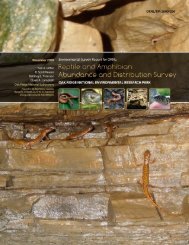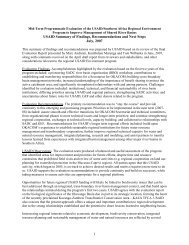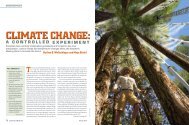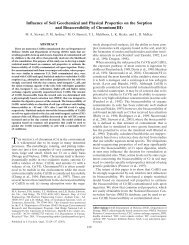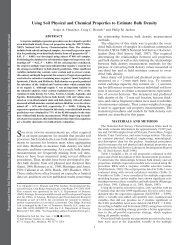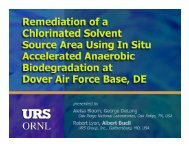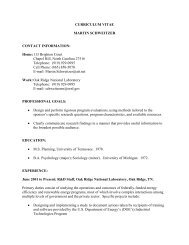oak ridge reservation physical characteristics and natural resources
oak ridge reservation physical characteristics and natural resources
oak ridge reservation physical characteristics and natural resources
You also want an ePaper? Increase the reach of your titles
YUMPU automatically turns print PDFs into web optimized ePapers that Google loves.
input from the public. The agreement enables DOE to assist in paying for <strong>natural</strong> resource damages at<br />
the Lower Watts Bar reservoir caused by DOE’s activities on the ORR.<br />
12.2 NATURE CONSERVANCY BIODIVERSITY RANKED AREAS<br />
More than 270 occurrences of significant plant <strong>and</strong> animal species were recognized by The<br />
Nature Conservancy in its report of biodiversity on the ORR as part of Common Ground, the DOE<br />
Future L<strong>and</strong> Use Initiative (The Nature Conservancy 1995). In addition, using a national ranking<br />
system, The Nature Conservancy identified more than 69 preliminary conservation sites with<br />
occurrences of rare species <strong>and</strong> communities <strong>and</strong> other important features (e.g., caves, springs). These<br />
sites generally had clusters of important species or communities, with special emphasis placed on<br />
those species <strong>and</strong> elements designated as globally imperiled, rare, or uncommon in The Nature<br />
Conservancy <strong>and</strong> Natural Heritage Network ranking system. The sites also include the l<strong>and</strong>scape<br />
features <strong>and</strong> ecological processes (i.e., watersheds) believed to be important for sustaining the<br />
occurrences of important species <strong>and</strong> communities.<br />
The sites were evaluated <strong>and</strong> given a biological significance ranking (BSR) based on their<br />
conservation significance. Sites on the ORR were rated BSR-2 (very high significance), BSR-3 (high<br />
significance), <strong>and</strong> BSR-4 (moderate significance). The BSR-5 category (of general biodiversity<br />
interest) was not used in The Nature Conservancy’s report, although it notes that “forested l<strong>and</strong> on<br />
ORR would fit in this or an above category.” The Nature Conservancy areas of biological<br />
significance are identified in Fig. 12. The Nature Conservancy maintains ORR records of rare plant<br />
<strong>and</strong> animal species in the Biological <strong>and</strong> Conservation Database.<br />
12.3 NATURE CONSERVANCY LANDSCAPE COMPLEXES<br />
The Nature Conservancy report also recommended protection of three large l<strong>and</strong> areas (Fig. 12)<br />
on which are found many highly ranked conservation sites (i.e., those with rare communities <strong>and</strong> rare<br />
species, hardwood forests greater than 100 acres [40.5 ha] <strong>and</strong> critical watersheds) (The Nature<br />
Conservancy 1995).<br />
12.4 RESEARCH PARK ENDANGERED SPECIES HABITATS (NATURAL AREAS)<br />
Rare plant <strong>and</strong> animal species (state <strong>and</strong>/or federal c<strong>and</strong>idate <strong>and</strong>/or listed) are provided<br />
protection through p<strong>reservation</strong> of the habitat that is required for their survival. Such important<br />
habitat is established on the best available information about the need of the rare species <strong>and</strong> is<br />
protected through Research Park Natural Area designations. Figure 13 shows the ORR areas<br />
designated as habitat for rare species.<br />
12.5 RESEARCH PARK ENDANGERED SPECIES POTENTIAL HABITATS<br />
(REFERENCE AREAS)<br />
Reference areas serve two functions. They provide protection to habitat with high potential for<br />
rare plant or animal species while also protecting common or representative plant or animal<br />
communities that can serve as baseline areas for research <strong>and</strong> monitoring. Many of the areas<br />
originally designated as Research Park Reference Areas have been found to contain rare plant or<br />
animal species <strong>and</strong> have been assigned the Research Park Natural Area designation. Figure 13 shows<br />
these areas as potential habitat for rare species.<br />
27




